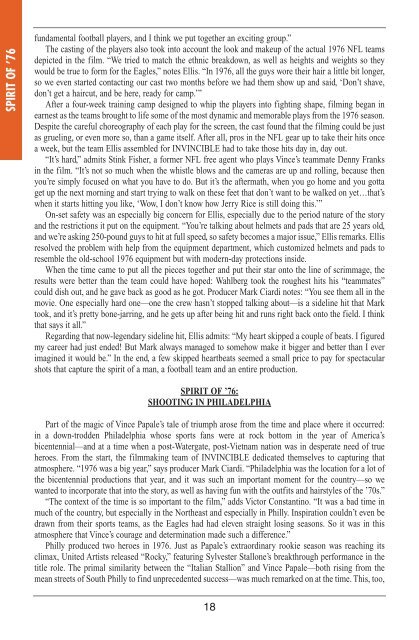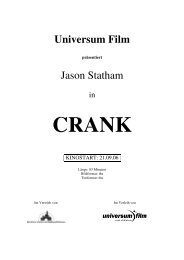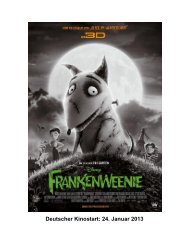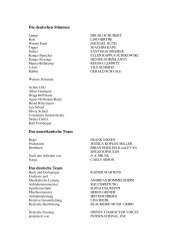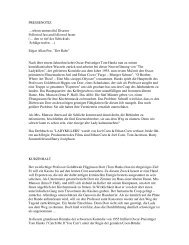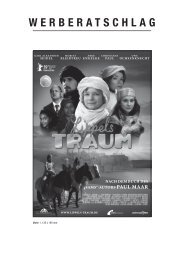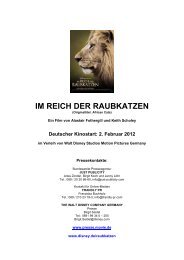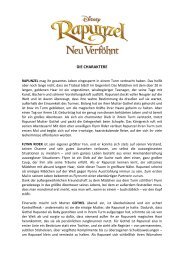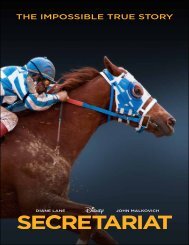invincible - Walt Disney Studios Motion Pictures Germany
invincible - Walt Disney Studios Motion Pictures Germany
invincible - Walt Disney Studios Motion Pictures Germany
You also want an ePaper? Increase the reach of your titles
YUMPU automatically turns print PDFs into web optimized ePapers that Google loves.
SPIRIT OF ’76<br />
fundamental football players, and I think we put together an exciting group.”<br />
The casting of the players also took into account the look and makeup of the actual 1976 NFL teams<br />
depicted in the film. “We tried to match the ethnic breakdown, as well as heights and weights so they<br />
would be true to form for the Eagles,” notes Ellis. “In 1976, all the guys wore their hair a little bit longer,<br />
so we even started contacting our cast two months before we had them show up and said, ‘Don’t shave,<br />
don’t get a haircut, and be here, ready for camp.’”<br />
After a four-week training camp designed to whip the players into fighting shape, filming began in<br />
earnest as the teams brought to life some of the most dynamic and memorable plays from the 1976 season.<br />
Despite the careful choreography of each play for the screen, the cast found that the filming could be just<br />
as grueling, or even more so, than a game itself. After all, pros in the NFL gear up to take their hits once<br />
a week, but the team Ellis assembled for INVINCIBLE had to take those hits day in, day out.<br />
“It’s hard,” admits Stink Fisher, a former NFL free agent who plays Vince’s teammate Denny Franks<br />
in the film. “It’s not so much when the whistle blows and the cameras are up and rolling, because then<br />
you’re simply focused on what you have to do. But it’s the aftermath, when you go home and you gotta<br />
get up the next morning and start trying to walk on these feet that don’t want to be walked on yet…that’s<br />
when it starts hitting you like, ‘Wow, I don’t know how Jerry Rice is still doing this.’”<br />
On-set safety was an especially big concern for Ellis, especially due to the period nature of the story<br />
and the restrictions it put on the equipment. “You’re talking about helmets and pads that are 25 years old,<br />
and we’re asking 250-pound guys to hit at full speed, so safety becomes a major issue,” Ellis remarks. Ellis<br />
resolved the problem with help from the equipment department, which customized helmets and pads to<br />
resemble the old-school 1976 equipment but with modern-day protections inside.<br />
When the time came to put all the pieces together and put their star onto the line of scrimmage, the<br />
results were better than the team could have hoped: Wahlberg took the roughest hits his “teammates”<br />
could dish out, and he gave back as good as he got. Producer Mark Ciardi notes: “You see them all in the<br />
movie. One especially hard one—one the crew hasn’t stopped talking about—is a sideline hit that Mark<br />
took, and it’s pretty bone-jarring, and he gets up after being hit and runs right back onto the field. I think<br />
that says it all.”<br />
Regarding that now-legendary sideline hit, Ellis admits: “My heart skipped a couple of beats. I figured<br />
my career had just ended! But Mark always managed to somehow make it bigger and better than I ever<br />
imagined it would be.” In the end, a few skipped heartbeats seemed a small price to pay for spectacular<br />
shots that capture the spirit of a man, a football team and an entire production.<br />
SPIRIT OF ’76:<br />
SHOOTING IN PHILADELPHIA<br />
Part of the magic of Vince Papale’s tale of triumph arose from the time and place where it occurred:<br />
in a down-trodden Philadelphia whose sports fans were at rock bottom in the year of America’s<br />
bicentennial—and at a time when a post-Watergate, post-Vietnam nation was in desperate need of true<br />
heroes. From the start, the filmmaking team of INVINCIBLE dedicated themselves to capturing that<br />
atmosphere. “1976 was a big year,” says producer Mark Ciardi. “Philadelphia was the location for a lot of<br />
the bicentennial productions that year, and it was such an important moment for the country—so we<br />
wanted to incorporate that into the story, as well as having fun with the outfits and hairstyles of the ’70s.”<br />
“The context of the time is so important to the film,” adds Victor Constantino. “It was a bad time in<br />
much of the country, but especially in the Northeast and especially in Philly. Inspiration couldn’t even be<br />
drawn from their sports teams, as the Eagles had had eleven straight losing seasons. So it was in this<br />
atmosphere that Vince’s courage and determination made such a difference.”<br />
Philly produced two heroes in 1976. Just as Papale’s extraordinary rookie season was reaching its<br />
climax, United Artists released “Rocky,” featuring Sylvester Stallone’s breakthrough performance in the<br />
title role. The primal similarity between the “Italian Stallion” and Vince Papale—both rising from the<br />
mean streets of South Philly to find unprecedented success—was much remarked on at the time. This, too,<br />
18


